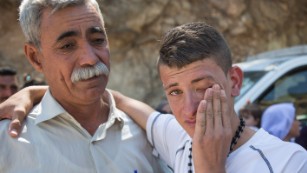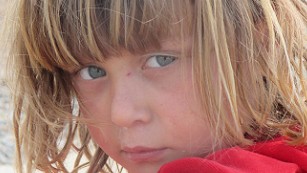On an abandoned chicken farm, a few dozen Yazidi volunteers in mismatched uniforms go through their drills. They are training for an offensive they have long dreamed of: to reclaim the town of Sinjar, their home until ISIS stormed in.
The world watched in horror last year as some 50,000 Yazidis scrambled up Mount Sinjar in northern Iraq to escape the ISIS onslaught. Many more hundreds were massacred, while teenage girls and women were sold into slavery.
The volunteers at the camp have horrific stories to tell — of their escape, the monthslong battles with ISIS that followed, the relatives they lost or who are still missing. So do the many Yazidi families still camping on the mountain.
‘Hundreds’ of Yazidi women killing themselves in ISIS captivity
Some 5,000 Yazidi fighters have been mobilized under the command of the Kurdish Peshmerga to take the battle to ISIS. Most are farmers; a very few have military experience.
‘We withstood a huge enemy’
The commander of the front-line position at the village of Hardan is 66-year old Kheiru Khalaf, whose tired eyes hint at the constant battles of the last year.
“We need international support, we need heavy weaponry, especially now,” he said.
“We stood against ISIS with nothing but machine guns. We withstood a huge enemy and stood strong. We need your help.”
In the skies above their camp, there’s the quiet hum of U.S. F-16s at high altitude as they look for targets in Sinjar and nearby Tal Afar — and try to destroy ISIS positions before the treacherous ground offensive begins.
A few hundred meters away is a village still held by ISIS. The Yazidis’ front line is frequently hit by mortar fire. The day after we visited the camp, two vehicle suicide attacks were launched against it. Both vehicles were destroyed before they reached the Yazidis’ positions.
Around the camp the tunnels and fortifications that ISIS built are still visible. So are reminders of the atrocities it committed here.
Just behind the front lines, the disturbed earth is dotted with remnants of clothing, even part of a scalp. It was here, according to the Yazidis, that 150 women and children were murdered and dumped into a mass grave. Some were months old; some were 80.
A few roses flutter in the breeze under the blue autumn sky; but otherwise an eerie silence hangs over the site.
For the fighters at this position, the site of the massacre feeds their loathing for ISIS and their impatience to advance. But they know the way ahead will be bloody. Peshmerga commanders estimate some 300 ISIS fighters are still inside Sinjar and likely plan to die there. They also believe they will encounter hundreds of landmines and booby traps.
Strategic location
Sinjar is an important prize in the battle against ISIS because it sits on the main highway between the city of Mosul — ISIS’ crown jewel — and its territory in Syria. Cut this route and ISIS would find it much more difficult to resupply Mosul. The “caliphate” would almost be split in two.
Fleeing ISIS tyranny: Agony of the Yazidis
The Yazidi fighters have a small collection of antique rockets; we are shown one made in Yugoslavia in 1957. But they do have some foreign helpers. One is called Mike, a bearded Englishman in his 50s who once served in the French Foreign Legion. Another is Michael Ibrahim from California, a muscular former soldier who served in Iraq with the U.S. Army’s First Infantry Division.
He felt impelled by media coverage of the Yazidis’ plight to come to northern Iraq.
“They’re facing a grim reality of a well-supplied, well-armed, well-trained enemy and they’re doing their best,” Ibrahim told CNN.
“These people are fighting to save families and to keep their homeland from a really great evil. And it really hit home to me, it really hit the heart and I had to come out,” he said.
The wide plain that straddles the Iraqi-Syrian border is dotted with destroyed buildings. Some were the homes of Yazidis — blown up by ISIS or struck by the mortars and Katyusha rockets it rained down on the quiet farming villages during its lightning advance in the summer of 2014. Others were ISIS command posts struck from the air when Kurdish forces retook this area last December. On the roadside near Hardan sits the rusting hulk of a Humvee — given to the Iraqi Army by the United States, seized by ISIS and then bombed by the U.S. Air Force.
‘God’s will’ protected Yazidis’ holiest shrine
The one village that ISIS did not capture here is Sharaf al-Din. Today, Yazidis are returning here — homes are being repaired and electricity has been restored. But for four months, a couple of dozen fighters with AK-47s held off wave after wave of ISIS attacks, including a suicide bombing by a Chechen. They had little to eat, could only contact each other by shouting, and had to climb into the mountains to retrieve the occasional airdrop of weapons and ammunition from the Kurds.
Asked how they resisted for so long, Khalaf gestures to the Yazidis’ holiest shrine, which sits on the hill behind the village. A gleaming conical building, it stands on a site that’s the gravesite of the religion’s founder. There has been a shrine at the site since 1274.
“It was God’s will. Daesh wanted to destroy our temple,” he says, using the Arabic acronym for ISIS. But the temple, and Khalaf, survived the onslaught.

In the nearby village of Snuny, a man named Nuri told us that if ISIS had succeeded in seizing the village and destroying the temple, it would have been as though they had taken all of Sinjar. “It would have been like Israel taking control of the Kaaba,” the holiest shrine in Islam, he said. “It’s the birthplace of our religion.”
On barren mountaintop, ‘we really want to go home’
As the Yazidi men prepare to retake Sinjar, hundreds of women and children endure on the barren, windswept mountain above, crammed into tents with nothing but tarpaulins to keep out the rain. Among them is Buha Sabri, a slight 30-year-old surrounded by her nine daughters.
“The mountain is so cold. You can see, there is nothing up here,” she told CNN. She worries that even though her children escaped ISIS, the winter cold may claim them.

Buha has other worries as well. Her sister and two teenage nieces were seized by ISIS. She has no idea where they are and prays they are still alive and not somewhere in the ruins of Sinjar. Other Yazidi families relate tales of the brainwashing of their children in ISIS captivity.
“We really want to go home to Sinjar. The thought of going home makes us happy, but more important to us are our girls,” Sabri said, cradling the youngest of her children.
“Where are they? Will they take them even further away? Will they be caught in the fighting?”
Throughout the centuries, the Yazidis have been persecuted by one group after another.
“Seventy-five times we have been massacred,” Khalaf said. “Once we were 48 million people. Now there are 1 million of us.”
On the front lines at Hardan, as we prepared to leave, one of the Yazidi fighters began reciting a poem — half-verse and half-song. Soon he had a chorus.
The verses spoke of lost honor, slaughtered wives and sisters. Empty homes left behind.
A reminder of what’s at stake for a people driven to the verge of extinction in their homeland.
As reported by CNN
